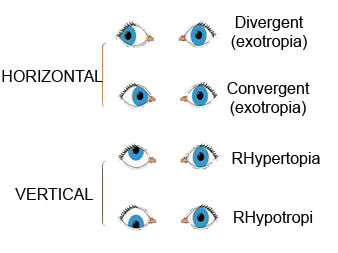Squint (also known as strabismus) is an imbalance of eye muscles that cause one or both eyes to be out of alignment. It can occur at birth, during childhood and/or later in adulthood. Squint that develops in adulthood is frequently a result of an underlying vascular disease such as diabetes or high blood pressure that affects the nerves leading to the eye. Squint in children could be due to refractive error. Sometimes an eye tumour (such as retinoblastoma) may present as a squinting eye.
Photograph showing a child with squint

Squinting eye (Left eye looking inward)
Diagram showing different types of squint

Signs & symptom
People with squint problem have physical appearance of their eyes appear crossed or misdirected. Some individuals may have symptom of blurred vision or double vision.
Complications
Proper assessment of the eyes is important to determine the cause of the squint. Subsequently, prompt and proper management is needed to prevent amblyopia (lazy eye).If retinoblastoma is the cause of the squint it can be fatal if left untreated.
Treatment
For management of squint in children; the doctor may choose to strengthen the misaligned eye(s) by placing a patch over the stronger eye (eye with better vision) so that the infant is forced to use the weaker eye. The patch may be moved to the other eye to keep a balance.
Surgery is also an option when indicated. It is performed to strengthen or weaken muscles that control the eyes.
Prevention
Children with squint need proper ophthalmologist assessment, to rule out possible underlying refractive error or severe underlying eye problems. It is important for the correction of squint that treatment begins as early as possible. A child’s nervous system continues to develop through infancy and can only be corrected during this sensitive period. Doing nothing and waiting till the child is big before getting treatment will only cause permanent and irreversible damage to the eyes
| Last Reviewed | : | 23 August 2019 |
| Writer | : | Dr. Joseph Vijaya Alagaratnam |
| Reviewer | : | Dr. Rosniza bt. Ab. Razak |







